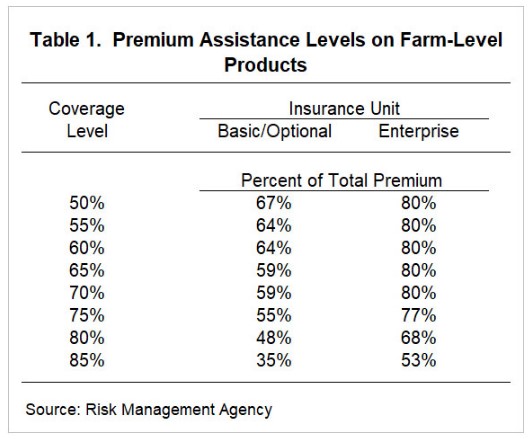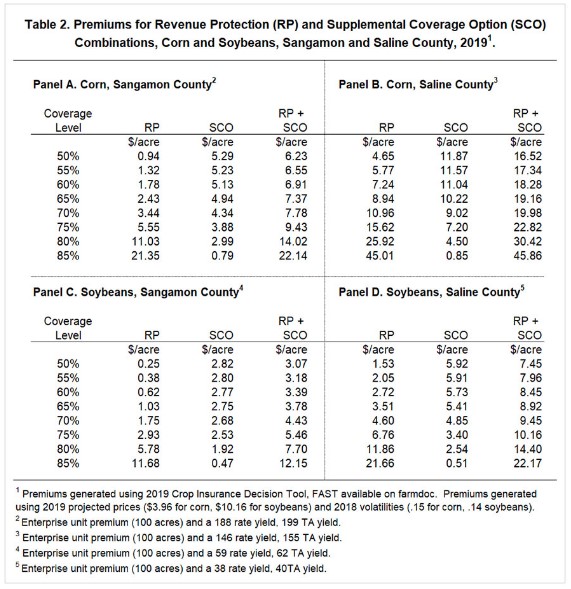By Gary Schnitkey
Department of Agricultural and Consumer Economics
University of Illinois
Supplemental Coverage Option (SCO) was introduced in the 2014 Farm Bill but was limited to acres where Price Loss Coverage (PLC) was the commodity title program choice. More farmers likely will be choosing PLC for the 2019 and 2020 marketing years, leading to more acres being eligible for SCO. SCO may be attractive to those farmers who find the costs of Revenue Protection (RP) at an 85% coverage level too high. Farmers interested in SCO should discuss eligibility options with crop insurance agents.
SCO Background
SCO is available to farmers who choose PLC for receiving commodity title payments. SCO is not available when Agricultural Risk Coverage (ARC) is chosen (farmdoc daily,
June 16, 2015). ARC was selected on over 90% of the base acres in corn and soybeans under the 2014 Farm Bill. As a result, SCO was not an option for most Midwest farmers. Similar to the 2014 Farm Bill, the 2018 Farm Bill again gives a choice between PLC and ARC. More farmers likely will choose PLC for 2019 and 2020, increasing the acres eligible for SCO.
SCO provides protection in a band from 86% down to the coverage level of an underlying COMBO product. If, for example, a farmer selects a 75% Revenue Protection (RP) product, SCO could be purchased from 86% to the 75% RP coverage level (see farmdoc daily,
December 17, 2014;
April 24, 2014).
The SCO band of coverage is based on county revenue given that the underlying Combo product is RP. That is, county revenue must fall below 86% of expected revenue before SCO makes a payment. As a result, the RP-SCO combination provides mixed coverage: Farm-level coverage is provided from the RP coverage level downward while county-level coverage is provided between 86% to the coverage level of the RP product.
The primary disadvantage of the RP-SCO combination is that the county-level coverage may not match losses on a farm. Sometimes a farm may have a loss while SCO will not trigger a payment. Conversely, it is possible for the farm not have a loss while the county-based SCO product triggers a payment.
Premiums under RP-SCO Combinations
The primary advantage of using SCO is lower farmer-paid premium. The costs of a RP-SCO combination usually will be lower than an 85% RP product when RP is purchased at less than 85% in the RP-SCO combination. Compared to RP 85%, the RP-SCO premium usually is lower for two reasons. First, county yields typically are less variable than farm yields, resulting in fewer payments for a county product than for a farm-level product at the same coverage level. Lower payments then result in a lower premium. Second, the premium assistance under SCO often is higher than for RP. SCO has a subsidy rate of 65%. For a product with an expected payment of $1, the SCO farmer-paid premium will be about $.35 ($.35 = $1 expected payment x (1 – .65 subsidy rate)). The 65% subsidy rate is higher than all subsidy levels for basic and optional units when the coverage level is above 50% (see Table 1). The 65% SCO subsidy level also is higher than the subsidy level at an 85% coverage level given enterprise units.

Table 2 shows examples of RP-SCO combinations for Sangamon and Saline Counties in Illinois. Sangamon County is a relatively low risk county while Saline County has higher risk. Premiums are shown for corn (Panels A and B) and soybeans (Panels C and D). Relationships of premiums are the same for both counties and crops.

Take corn in Sangamon County as an example. An RP 85% product has a farmer-paid premium of $21.35 per acre (see Panel A of Table 2). SCO for an RP with an 85% coverage level has a $.79 premium. For an 85% RP coverage level, the RP-SCO combination has a $22.14 per acre premium. An RP-SCO combination with an 80% RP coverage leave has a $14.02 per acre premium, with $11.03 premium from RP 80% and $2.99 from SCO from 86% to 80%. RP-SCO combinations have lower farmer-paid premium as the RP coverage level is decreased. A $22.14 combined premium result for an 85% coverage level, $14.02 premium results for an 80% coverage level, a $9.43 premium results for a 75% coverage level, and so on.
Who Should Consider SCO
Farmers purchasing RP at 85% coverage levels likely will not find SCO an attractive alternative. The SCO band from 86% to 85% coverage will provide little additional coverage. Any reduction of RP coverage level with an SCO band results in a crop insurance payment structure that is less correlated with losses on the insurance unit.
Farmers purchasing lower coverage levels could find SCO useful, particularly if the lower coverage level is selected so as to result in a lower farmer-paid premium. The farmer-paid premium for RP approximately doubles from the 75% coverage level to 80% coverage level. For example, soybean RP premium in Sangamon County goes from $2.93 per acre at a 75% coverage level to $5.78 at an 80% coverage level. Premiums again double from the 80% coverage level to the 85% coverage level. For soybeans in Sangamon County, RP premiums increase from $5.78 at an 80% coverage level to $11.68 at an 85% coverage level. A farmer currently at a 75% coverage level could include SCO for $2.53 additional premium, with the $5.46 premium for the RP-SCO combination being less than for a stand-alone RP 80% premium ($5.78) and RP 85% premium ($11.68). The addition of SCO to a RP 75% coverage level would improve coverage, providing county-level coverage above the 75% coverage level of the RP.